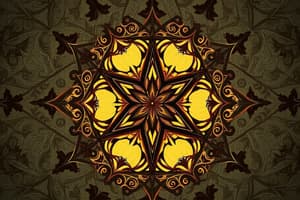Podcast
Questions and Answers
What type of quadrilateral has opposite sides that are parallel and congruent?
What type of quadrilateral has opposite sides that are parallel and congruent?
- Parallelogram (correct)
- Kite
- Rectangle
- Square
Which type of quadrilateral has all four angles congruent and all sides congruent?
Which type of quadrilateral has all four angles congruent and all sides congruent?
- Rectangle
- Rhombus
- Trapezoid
- Square (correct)
What is the area formula for a rhombus?
What is the area formula for a rhombus?
- Area = (1/2) * (product of diagonals) (correct)
- Area = length * width
- Area = (1/2) * (sum of parallel sides) * height
- Area = side length * side length
What is a quadrilateral called if all its vertices lie on a circle?
What is a quadrilateral called if all its vertices lie on a circle?
Which type of quadrilateral has one pair of parallel sides with congruent lengths and another pair of parallel sides with congruent lengths but different from the first pair?
Which type of quadrilateral has one pair of parallel sides with congruent lengths and another pair of parallel sides with congruent lengths but different from the first pair?
How many angles does a quadrilateral have?
How many angles does a quadrilateral have?
What is the sum of the interior angles in a quadrilateral?
What is the sum of the interior angles in a quadrilateral?
What do the diagonals of a quadrilateral divide it into?
What do the diagonals of a quadrilateral divide it into?
What is the maximum length of a diagonal in a quadrilateral?
What is the maximum length of a diagonal in a quadrilateral?
In Euclidean geometry, what is always true about the opposite angles in a quadrilateral?
In Euclidean geometry, what is always true about the opposite angles in a quadrilateral?
Flashcards are hidden until you start studying
Study Notes
Diving into Quadrilaterals: Properties, Diagonals, Types, Area Formulas, and Special Cases
A quadrilateral is a beautiful and fundamental geometric figure that consists of four sides, four vertices (corners), and four angles. This simple yet captivating shape has fascinated mathematicians and artists throughout history, serving as a building block for more complex shapes and designs. In this article, we'll delve into the fascinating world of quadrilaterals, exploring their properties, diagonals, types, area formulas, and special cases.
Properties of Quadrilaterals
Quadrilaterals come in different varieties due to the unique properties of their sides and angles. Here are some fundamental properties that all quadrilaterals share:
- Four sides
- Four vertices
- Four angles
Also, quadrilaterals possess these additional properties:
- The sum of the interior angles is always 360° (in Euclidean geometry).
- The opposite angles are always equal, and the sum of the adjacent angles is always 180°.
Diagonals in Quadrilaterals
Diagonals, or the line segments that connect any two non-adjacent vertices, are an essential part of quadrilaterals. They divide the quadrilateral into smaller shapes, such as triangles, trapezoids, or parallelograms.
- Length of diagonals: Since it is a straight line, a diagonal's length is always less than or equal to the sum of the lengths of the sides it connects (by the triangle inequality theorem).
- Intersection points: Diagonals never intersect at the quadrilateral's vertices. Instead, they intersect at a single point within the quadrilateral, known as the diagonal intersection point or diagonal foot.
Types of Quadrilaterals
Quadrilaterals come in many forms, each with specific properties and area formulas. Here are some common types of quadrilaterals:
- Rectangle: All four angles are right angles (90°) and opposite sides are congruent (equal).
- Square: All four angles are right angles (90°), and all sides are congruent.
- Parallelogram: Opposite sides are parallel and congruent.
- Trapezoid: No parallel sides and no perpendicular angles.
- Rhombus: All four angles are congruent, and all sides are congruent.
- Kite: Four sides are divided into two pairs of congruent sides, with four congruent angles between these pairs.
- Trapezoid with parallel bases: Parallel bases and no perpendicular angles.
- Trapezoid with a right angle: One right angle, and no parallel sides.
Area Formulas for Quadrilaterals
Each type of quadrilateral has a specific formula for finding its area:
- Rectangle: Area = length * width
- Square: Area = side length * side length
- Parallelogram: Area = base * height
- Trapezoid: Area = (1/2) * (sum of parallel sides) * height
- Rhombus: Area = (1/2) * (product of diagonals)
- Kite: Area = (1/2) * (product of longer sides) * (height perpendicular to longer sides)
- Trapezoid with parallel bases: Area = (1/2) * (sum of parallel sides) * height
- Trapezoid with a right angle: Area = (1/2) * (product of parallel sides) * height
Special Quadrilaterals
Some quadrilaterals possess unique properties or special characteristics:
- Golden Rectangle: A rectangle whose longer side has a length that is the golden ratio (approximately 1.618) times the length of its shorter side.
- Cyclic Quadrilateral: A quadrilateral whose vertices all lie on a circle.
- Diamond: A quadrilateral where all four angles are right angles (90°), and the sides are arranged in a diamond shape.
- Saddle Shape: A quadrilateral that has one pair of parallel sides with congruent lengths, and another pair of parallel sides with congruent lengths but different from the first pair.
- Circumscribed Quadrilateral: A quadrilateral that has all four vertices on a circle, with the circle being tangent to all four sides.
- Inscribed Quadrilateral: A quadrilateral that has all four sides as chords of a circle, and the four angles are interior angles of the circle.
In conclusion, quadrilaterals are an exciting and diverse geometric subject that offers a variety of properties, applications, and subtopics to explore. With a profound understanding of quadrilaterals, we can appreciate the beauty and elegance of mathematical shapes that surround us every day.
Studying That Suits You
Use AI to generate personalized quizzes and flashcards to suit your learning preferences.




